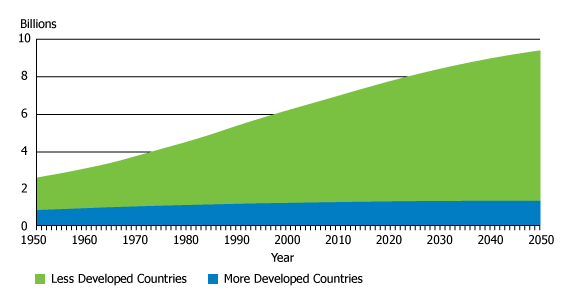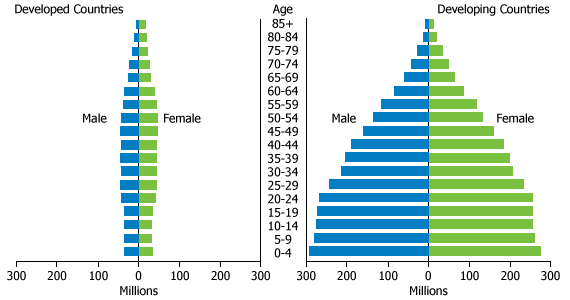Carl Haub
Demographer Emeritus

World population has surpassed 7 billion, and we are in the midst of history’s most rapid population expansion. The sixth billion and the seventh billion were added in record time—only 12 years for each milestone. (Watch PRB video “7 Billion and Counting”).
In 1900, world population was 1.6 billion, a total that had taken at least 50,000 years of human history to accumulate. But by the year 2000, world population reached 6.1 billion, in large part because of a dramatic positive achievement: the rapid spread of modern medicine and public health practices after World War II, starting in the 1950s. Health advances were “exported” to developing countries, often via international relief agencies. More infants and children survived, and a growing share of the world’s population lived longer, healthier lives.
In Europe and North America, those health advances took centuries to be fully established. Not so for developing countries—life expectancy at birth rose with never-before-seen speed, and high infant mortality rates began to decline.
But societies did not change as fast. Social norms and cultural factors—age at marriage, desired family size, and gender roles—all helped keep birth rates high. The growth rate in developing countries peaked in the late 1960s at 2.5 percent, and in the early 1980s, the growth rate was still 2.4 percent.
Many of the dire predictions, particularly in the 1960s regarding mass starvation, proved wrong. Along with improvements in agriculture, many developing countries adopted policies to lower birth rates and slow growth (with varying degrees of success).
What if the global population growth rate of the late 1960s had remained constant at 2.1 percent through today? World population would be 8.6 billion, and likely even larger. If birth rates had remained constant, the global growth rate would have risen as countries with higher birth rates grew more quickly. Continued improvements in life expectancy would have pushed growth rates even higher. We can only speculate, but world population could have reached as much as 10 billion by now.
Since 1980, most population growth has been concentrated in the world’s poorest countries, making it more difficult to lift large numbers of people out of poverty (see Figure 1). Sub-Saharan Africa’s population has more than doubled over the last 30 years, rising from 390 million in 1980 to 883 million today. Europe’s population grew more slowly, from 693 million in 1980 to 740 million in 2011.
Figure 1
World Population Growth

Source: United Nations Population Division, World Population Prospects: The 2010 Revision, medium variant (2011).
The annual world population growth rate in 1980 was 1.8 percent, compared to 1.2 percent today. The growth rate for developing countries remains four times higher than developed countries, 1.6 percent for developing countries and 0.4 percent for developed countries. In sub-Saharan Africa, the annual growth rate in 1980 was 2.8 percent, and it has only declined modestly to 2.5 percent today.
Total fertility rates vary widely among regions and countries (see PRB’s Interactive World Map and DataFinder). Worldwide, the total fertility rate (TFR, or the average lifetime births per woman) stood at 3.7 in 1980 and has declined to 2.5 today.
The TFR of developed countries saw only small changes between 1980 and 2011, from an average of 1.9 to 1.7 births per woman. By contrast, in developing countries, the TFR declined from 5.0 to 3.0, excluding the large statistical effect of China. Europe, along with the industrialized countries of East Asia (Japan, South Korea, and Taiwan) passed into a new era of extremely low birth rates. The TFR in South Korea is now 1.2 and 1.4 in Germany, Japan, and Spain for example. Taiwan has the lowest TFR in the world: 0.9 children per woman in 2010.
For some time now, the global demographic situation has seen a great divide. Two population pyramids (Figure 2) illustrate the age structure and size of the population of developed and developing countries. Low birth rates and few young people in developed countries (not a typical “pyramid” shape) ensure slow population growth or even population decline, and unprecedented proportions of elderly whose demands on pension systems and long-term health care will increase dramatically.
The contrast with the pyramid for developing countries could not be more dramatic. The large share of young people reaching their childbearing years creates the momentum for continued high levels of population growth. Even with declines in birth rates in many developing countries, rapid growth is ensured.
Figure 2
Age and Sex Structure of Developed and Developing Countries

Source: United Nations Population Division, World Population Prospects: The 2010 Revision, medium variant (2011).
A variety of figures are quoted for future population size. The 2010 projections of the United Nations Population Division show world population at 9.3 billion in 2050; the U.S. Census Bureau’s International Data Base puts that total at 9.4 billion; and PRB’s 2011 World Population Data Sheet projects 9.6 billion. Considering the uncertainty we face, those figures are not as far apart as they may seem.
Since virtually all future population growth will be in developing countries and growth in the developed countries has basically ceased, the developing countries are driving future trends. It is vital to realize that population projections are the result of assumptions. Generally, the assumptions made regarding future birth rates carry more weight than those for death rates. Therefore, the projections cited above make this fundamental assumption: Birth rates in developing countries will decline smoothly and without interruption until reaching a TFR of two children or fewer per woman as TFRs did in the developed countries. Citing these projected figures is meaningless without including this assumption.
That basic assumption is not unreasonable, nor is it without precedent. The TFR has declined in many developing countries and, in some, to below two children per woman, as in Cuba and Chile. In others, the decline has “stalled” at a medium level of three to four children, as in Jordan and Senegal. In still others, it has not declined much, if at all, from high levels of five, six, or more children, as in Afghanistan and Nigeria.
When considering a population projection for a developing country, several questions must be asked:
Of the three UN projections for population growth (low, medium, and high), the medium projection suggests that 8 billion will be reached in 2025, 14 years from now, but only if the smooth, uninterrupted fertility decline that this projection assumes continues in all developing countries. Clearly, 8 billion arriving in 12 years, as did billions 6 and 7, is well within the realm of possibility.
